Individualized Math With “Bead Trading”
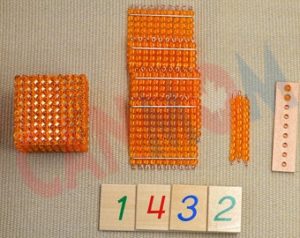
While this website focuses on literacy skills, I’m also including a description of the individualized math program I developed. I will describe it here as I used it in my K-2 classroom, so you can adapt it for use in your own situation. It’s completely individualized, so preschool through elementary students can play it together.
I initially offered Bead Trading only as a choice activity, But I noticed how quickly the children caught on to number concepts while playing. So I developed a sequential structure of increasingly complex activities to for them to move through. With that, it became the hands-on structure for our math program.
We worked with it during a period devoted exclusively to math. During that time, we had two Bead Trading Tables going — one for practice, run by an older student or parent. I ran the other.
I rotated students through my group to assess whether individuals were ready to move on to the next level.* The rest of the class of 28 students, or so, was assigned to either be working on paper/pencil math work, or choosing from other math materials on the shelves.
Let’s look first at the the materials needed for the game, then how it’s played, and finally, the levels the children worked through.
Bead Trading materials
Here again are the original Montessori Golden Beads that inspired me to create this game. They include a Cube of 1,000 beads, Squares of 100, Bars of 10, and Singles.
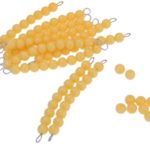
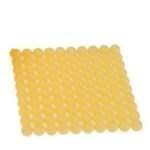
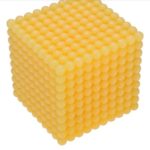 Sources for Beads: When my daughters were preschoolers, I established a Montessori school. There, we ordered the bead materials from Montessori’s original supplier, Nienhuis.
Sources for Beads: When my daughters were preschoolers, I established a Montessori school. There, we ordered the bead materials from Montessori’s original supplier, Nienhuis.
But for my K-2 classroom, I made a set myself, using beads and wire I got at a local craft store. An even less expensive version that would serve the same purpose can be made of beans and popsicle sticks.
But if at all possible I’d use beads, as they make the game more special. The original version of the beads, pictured here, is available online from various places, including www.nienhuis.com.
Number of Beads Needed: Only 1 One Thousand Cube is needed per classroom, as it is expensive, and used just to show the concept. (If the children are keeping a running score of games from day to day, the first time someone reaches 1,000, all running scores drop again to zero.)
The number of 100’s Squares, 10’s Bars and Ones needed is equal to 9 times the number of children you want to be playing at a time. Play moves along best with 4 players, so a table would need 4 x 9 = 36 of each type.
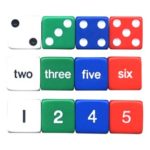 Dice: I bought dice, with dots, and made the other dice by writing with a wide-tipped marking pen on blank wood cubes I found at a craft store. But I see that dice not only with dots, but numerals, and words are now available online.
Dice: I bought dice, with dots, and made the other dice by writing with a wide-tipped marking pen on blank wood cubes I found at a craft store. But I see that dice not only with dots, but numerals, and words are now available online.
Self-checking Strips: I made a variety of “self-checking” strips that allowed the children to be sure they read the dice correctly. For example, the strip for checking numerals showed the corresponding number of dots:
| 1 *| 2 ** | 3 *** |4 **** | etc.
With this the child could count the dots to verify the numeral. A child at the more advanced level should have one for words.
organizing the table for play
Children at any skill level can play together in a group. For each child brings with them the materials appropriate for their level. (See below for how I determined a child’s Math Level.)
Each table group has —
 One Game Board For Each of the 4 Players: The board has sections marked with the appropriate numerals and/or names spelled out as shown. (I made our boards from heavy card stock and laminated them.)
One Game Board For Each of the 4 Players: The board has sections marked with the appropriate numerals and/or names spelled out as shown. (I made our boards from heavy card stock and laminated them.)
A Banker: One”older” person, who does NOT play, pays out the beads after each roll. (Some older children in the class can do it, but a cross-age tutor is best, as the children love to have an older student they look up to paying attention to them. And of course, an adult will also do.)
A Spinner: It indicates either “High” or “Low.” The children kept a running total from one day to the next, just to see who can make it to 1,000 first.
But they also liked to see who won that day’s game. So the spinner was used at the END of the game to determine the winner that day. With this, there was no temptation to cheat to get the highest total.
There was no prize for the winner — just the pleasure of winning.
the bead trading game
The Rules: This game is regulated by the base 10 number system. So a player can only have 9 ones, 9 tens bars and 9 one hundred squares on their board at any one time.
So, for instance, if a child already has 8 Single One’s and they roll a 5, they will have to trade in their 8 Single One’s and 2 of the beads they won to buy a Ten Bar, leaving them with 1 Ten Bar and 3 single beads. Then they place them on their board in the appropriate sections.
There are two skills being developed here. A child must —
1. compute their winnings, according to the dice, and
2. figure out how to trade their beads so they have the correct type (single, tens bar, or hundreds square), that can fit on their board, according to the base 10.
It’s always the player who must state their total roll of their dice, so a child who’s just moved to a higher level, stays at the teacher’s table until able to do it on their own.
And once a player is experienced in this game, the Banker always waits for the child to say both the amount and type of beads they should get. Any banker who repeatedly fails to wait for an EXPERIENCED player to STATE THEIR WINNINGS in both of these ways, will be barred from being Banker.
But –when a child is new to the game, the Banker waits and helps them figure out how to TRADE WHAT THEY HAVE. So for example:
Say the child in the example above is young and new to the game. They already have 8 SINGLE beads sitting in the ONES place on their board. Now they have rolled a 5. So when they role the 5, the Banker will put the 5 new singles in the ONES PLACE on that child’s board (or hand them over and let the child do it). Then the Banker will WAIT, to see what the child does.
If that new child has not yet fully absorbed the concept of base 10 and hesitates for long, the Banker (and probably the other children) will remind the child they can only have 9 beads in the ONES place. Then if the child doesn’t do it right away, the Banker can then show the child that they have enough in the one’s place to trade 10 single beads for one TEN BAR. This leaves the child with a TEN BAR in the TENS PLACE and THREE SINGLES in the ONES PLACE. **
It won’t take long until that same child — having played the game several times, — will not only have learned to add the dice rapidly in their head, but also, they will have absorbed the concept of base 10 .
With this combination of new skills, soon they will not have to wait for a Banker to show them the type of beads they will end up with. Instead, before the Banker has given them anything, we see the child (having rolled as in the example above) handing the Banker 5 of their single beads and saying, “I’ll buy a TEN BAR!” That leaves them with 3 beads remaining in the one’s section. And they place the 10’s bar where it belongs.
It’s amazing to see how automatically even very young children can compute and trade according to the base ten — just from playing this game. And their computing goes on from there to subtraction and all the way up, to include multiplication.***
Individualized Math Levels and Materials
The math program was structured by a series of 5 math levels, with different dice and materials for each level. Each child then had a Zip-lock plastic bag with their own set of materials, which we kept in a box near the Bead Trading Table, alphabetized.
From Level 1 to mid-way through Level IV, they are only adding. The changes proceed as follows:
Level I: 1 dice with dots. Later 2 dice with dots. (To learn to count.)
Level II: 1 numbered dice with a number strip to keep at the table while playing — for self-checking.
Level III: 2 dice — 1 numbered and 1 with dots. Also a number strip.
Level IV: The following changes slowly, in this sequence —
- change dice to 2 numbered, below 6 (later change to words, if appropriate for that child, and provide a strip with words and numerals.)
- change one dice to numbers 6 and above
- add score cards (these were small score cards, made of regular paper, with spaces for writing out scores: 2+5 = 7, etc.)
- add dice showing + or – (Until now, the children understood they were to add.)
- change from beads to play money
- change both dice to higher numbers
Level V: After introducing multiplication to a child —
- use 2 dice below five, along with and a dice marked X — so the child multiplies
- use 1 dice below five, another above 5, along with a dice marked with X
- both dice above 5 with X
- revert to practice with dice with lower and higher numbers and a 3rd dice with +, – and X
Determining a child’s math concept level
 I used Unifix cubes to help determine each child’s concept level, using a simple test, as follows:
I used Unifix cubes to help determine each child’s concept level, using a simple test, as follows:
The first time I tested a child, I began with 5 cubes (all the same color). Holding out the five cubes, hooked together, I had the child count them out loud.
Then I put them behind my back, broke some off and showed them to the child, asking them to count what I had in my outstretched hand.
After they counted I asked, “How many do you think I have behind my back?” I tried this with different combinations that added to 5: 1 & 4, 2 & 3, 4 & 1, 3 & 2.
If they answered correctly, with little hesitation, I added a cube to the total and hooked them all together again.
First, I had them count the 6, then hid them behind my back — then tested them again, as before.
I kept that up until the child faltered — could not keep the number of cubes in their head. That number then became the concept they were to work on in Bead Trading.
Finally, I changed the dice and other materials in their bag and marked their concept level in my class chart.
There were some restrictions for what other materials could be in use during math time, as basically they were to be focusing only on math during this time. To see those and what other types of materials — in addition to math — were available during other times, see Supportive Environment.
one more example of the power of learning by doing something with meaning
Watching the children respond to Bead Trading was one more case that convinced me how much more powerful — plus easier and more fun — it is to let children learn by doing something in a real life situation.
Bead Trading showed once again that what works best is modeling for the child what’s possible, and letting them absorb the concept and practice at their own pace — by doing something that has meaning for them. (The same as with speaking, writing and reading.)
————–
* I used the same basic record keeping system as I did with writing. See “Forms for Guiding Student Progress” here and modify for math, as you wish. When I needed to give “lessons” to a few, showing them howto operate at their next level, I turned my table over to an aide or cross-age tutor who ran the table with other students, just for practice.
** Please notice we were not telling the child about the concept of base 10. We were simply modeling it — showing them how it works. And with this, they got it rather quickly.
*** We had one surprising case of a kindergarten boy who caught on to the game so quickly that he began to use the multiplication dice at Level V. One day, his mother came to school only to ask if I was teaching multiplication to the kindergarten children, as her son had been surprising them by frequently — in an off hand manner — multiplying two numbers in his head. (I never included division, but we could have managed it with the beads, by just having them round up each time. But I wasn’t sure how that would affect their thinking, so I didn’t try it.)